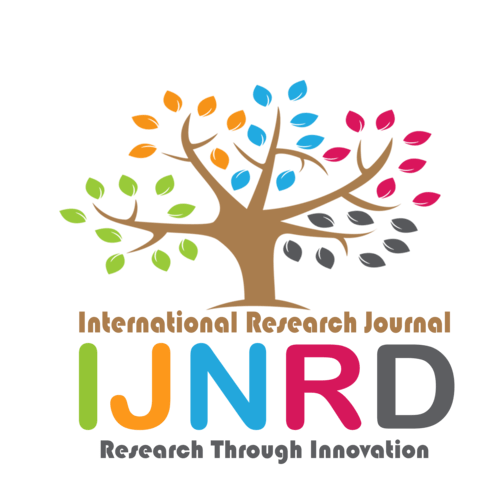|
|||||||||||||||

|
INTERNATIONAL JOURNAL OF NOVEL RESEARCH AND DEVELOPMENT International Peer Reviewed & Refereed Journals, Open Access Journal ISSN Approved Journal No: 2456-4184 | Impact factor: 8.76 | ESTD Year: 2016 Scholarly open access journals, Peer-reviewed, and Refereed Journals, Impact factor 8.76 (Calculate by google scholar and Semantic Scholar | AI-Powered Research Tool) , Multidisciplinary, Monthly, Indexing in all major database & Metadata, Citation Generator, Digital Object Identifier(DOI) |
||||||||||||||
Issue: May 2024
Volume 9 | Issue 5
Review Result and Publication of Paper within : 2-3 days
Click Here For more DetailsFor Authors
Forms / Download
Published Issue Details
Editorial Board
Other IMP Links
Facts & Figure
Impact Factor : 8.76
Issue per Year : 12
Volume Published : 9
Issue Published : 96
Article Submitted :
Article Published :
Total Authors :
Total Reviewer :
Total Countries :
Indexing Partner
Join RMS/Earn 300
Licence
This work is licensed under a Creative Commons Attribution-NonCommercial 4.0 International License







|
Published Paper Details
|
|
| Paper Title: | EXPLORING THE HISTORICAL AND CULTURAL IMPLICATIONS OF VIOLENCE AGAINST THE DALITS IN BASAVAS |
| Authors Name: | Vanapally Vijaya lakshmi |
| Download E-Certificate: | Download |
| Author Reg. ID: |
IJNRD_208410
|
| Published Paper Id: | IJNRD2311105 |
| Published In: | Volume 8 Issue 11, November-2023 |
| DOI: | |
| Abstract: | The system of votive offerings of girls to the deities in Brahmanic temples is more prevalent in South India than in North India. This system was called the Devadasi system. The Chola, Chera, and Pandya Kings built huge temples for their gods. They felt constructing huge temples would provide shelter to the people during floods, cyclones, or any other natural disasters. Hence, it was appointed to girls to maintain these temples. The main function of these girls is to sing, entertain people, and take care of deities. These girls were called ‘Devadasi’ which means female slaves of God, and they are known by different names in different areas. For instance, they are called Mahari’s in Kerala, Natis in Assam, and Thevaradiyar in Tamil Nadu. Muralis in Maharastra, Basavis in Karnataka, Bhavanis in Goa, Kudikar on the West Coast, Bhogam or Jogin in Andhra Pradesh (1 Patra), and Mahari in Orissa This system reached climax in 12th century. They enjoyed high esteem as they were closed confident of the god. They were experts in music and dance. As years passed their services shifted from god to earthly gods (King) , Priests and lords. They are forced to do service not only to the deities but also to the lords and rich devotees of the deities. In short, they started living the life of Prostitute with religious sanction and customary backing. The Caste system that showed imbalances and discrimination against lower caste sowed the seeds of the system into economically, politically, and socially disadvantaged lower caste Dalits and one such system is Jogatis or Basavis in Karnataka which is associated with women of leather community. An attempt is made through this paper to study the Basavis cult under the matrix of Caste and Patriarchy. This cult characterized a system whereby women of lower caste are kept subordinate to men of higher caste in several ways. The vested interest of upper caste for gaining accessibility to desire of women of lower caste to satisfy their extra marital sexual needs led to evolution of this custom. Over period this practice has represented in clear violation of Human Rights with these women who initially perform sexual favours to upper caste and later become public property through this divine institution of Prostitution. This paper also analyses major reasons for the establishment of the cult, important rituals practiced by them, impact of the cult on SC Women and reasons why this system is still prevalent today and measures taken by government to curb the cult. Governmental steps taken to eradicate and help the basavis. Keywords: Patriarchy, Discrimination, Divine Prostitution Introduction: The town of Basavas, like many regions in India, bears a deep historical and cultural heritage intertwined with the troubling issue of violence against the Dalit community. The term "Dalit" refers to those who have been historically marginalized, discriminated against, and subjected to violence due to their caste, often relegated to the lowest rungs of the Indian social hierarchy. This study endeavors to delve into the historical roots and cultural underpinnings of violence against Dalits in Basavas, shedding light on a persistent and deeply ingrained social issue. |
| Keywords: | Patriarchy, Discrimination, Divine Prostitution |
| Cite Article: | "EXPLORING THE HISTORICAL AND CULTURAL IMPLICATIONS OF VIOLENCE AGAINST THE DALITS IN BASAVAS", International Journal of Novel Research and Development (www.ijnrd.org), ISSN:2456-4184, Vol.8, Issue 11, page no.b38-b47, November-2023, Available :http://www.ijnrd.org/papers/IJNRD2311105.pdf |
| Downloads: | 000118755 |
| ISSN: |
2456-4184 | IMPACT FACTOR: 8.76 Calculated By Google Scholar| ESTD YEAR: 2016 An International Scholarly Open Access Journal, Peer-Reviewed, Refereed Journal Impact Factor 8.76 Calculate by Google Scholar and Semantic Scholar | AI-Powered Research Tool, Multidisciplinary, Monthly, Multilanguage Journal Indexing in All Major Database & Metadata, Citation Generator |
| Publication Details: |
Published Paper ID:IJNRD2311105 Registration ID: 208410 Published In: Volume 8 Issue 11, November-2023 DOI (Digital Object Identifier): Page No: b38-b47 Country: Hanamkonda, Telangana, India Research Area: Social Science and Humanities Publisher : IJ Publication Published Paper URL : https://www.ijnrd.org/viewpaperforall?paper=IJNRD2311105 Published Paper PDF: https://www.ijnrd.org/papers/IJNRD2311105 |
| Share Article: | |
|
Click Here to Download This Article |
|
| Article Preview | |
|
|
|
Major Indexing from www.ijnrd.org
| Semantic Scholar | Microsaoft Academic | ORCID | Zenodo |
| Google Scholar | ResearcherID Thomson Reuters | Mendeley : reference manager | Academia.edu |
| arXiv.org : cornell university library | Research Gate | CiteSeerX | PUBLON |
| DRJI | SSRN | Scribd | DocStoc |
ISSN Details
 |
 |
ISSN: 2456-4184
Impact Factor: 8.76 and ISSN APPROVED
Journal Starting Year (ESTD) : 2016
DOI (A digital object identifier)
Conference
Open Access License Policy
Important Details
Social Media
| Copyright © 2024 - All Rights Reserved - IJNRD |












Facebook Twitter Instagram LinkedIn